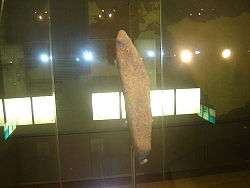Zenata

The Zenata (Berber: Iznaten, ⵉⵣⵏⴰⵜⴻⵏ or Iznasen, ⵉⵣⵏⴰⵙⴻⵏ; Arabic: زناتة Zanātah) were a Berber tribe, who inhabited an area stretching from western Egypt to Morocco in antiquity along with the Sanhaja and Masmuda.[1] Their lifestyle was mainly nomadic.[2][3]
Islam
The Zenata adopted Islam early, still in the 7th century. While other Berber tribes continued to resist the Umayyad Caliphate conquest well into the 8th century, they were quickly Arabized.[4] They also formed a substantial contingent in the subsequent Muslim conquest of Iberia.
Society
The 14th-century historiographer Ibn Khaldun reports that the Zenata were divided into three large tribes: Jarawa, Maghrawa, and Banu Ifran. Formerly occupying a large portion of the Maghreb (Tamazgha), they were displaced to the south and west in conflicts with the more powerful Kutama and Houara.
Politics
In the 10th century, the Zenata were allied with the Caliphate of Cordoba against the Fatimids. The Zenata regained some political power during the 13th century with the rise of the Zayyanid dynasty. Two Zenata dynasties, the Marinids and the Wattasids, ruled Morocco from the mid-13th to mid-16th century.
Languages
French linguist Edmond Destaing in 1915 proposed "Zenati" as a loose subgrouping within the Northern Berber languages, including Riffian Berber in northeastern Morocco and Shawiya Berber in northeastern Algeria.[5]
See also
External links
| Wikisource has the text of the 1911 Encyclopædia Britannica article Zenata. |
- Rachid Bellil, Université d'Alger. "Les Zénètes du Gourara d'hier à aujourd'hui (Sahara Zenatas)". Retrieved December 9, 2012.
- Norman Roth. Jews, Visigoths, and Muslims in Medieval Spain: Cooperation and Conflict. Retrieved December 9, 2012.
References
- ↑ Nelson, Harold D. (1985). Morocco, a country study. Area handbook series. Washington, D.C.: The American University. p. 14.
- ↑ Ilahiane, Hsain (2004). Ethnicities, Community Making, and Agrarian Change: The Political Ecology of a Moroccan Oasis. University Press of America. p. 44.
- ↑ Wright, John (2012). A History of Libya. Hurst. p. 48.
- ↑ "The disappearance of Zenata to the eighth century, them covering a quarter of North Africa, is one of the most extraordinary facts the Tamazgha has ever known." Les oasis du Gourara (Sahara algérien) Par Rachid Bellil, (1999), p.77
- ↑ Edmond Destaing, "Essai de classification des dialectes berbères du Maroc Archived September 4, 2011, at the Wayback Machine.", Etudes et Documents Berbères 19-20, 2001-2002 (1915). Edmond Destaing, "Note sur la conjugaison des verbes de forme C1eC2", Mémoires de la Société Linguistique de Paris, 22 (1920/3), pp. 139-148